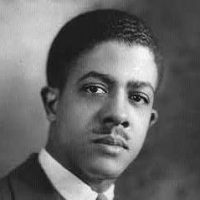

Malvin Gray Johnson (28 January 1896-1934) was an African American painter, born and raised Greensboro, North Carolina. His family moved to New York, where he studied art at the National Academy of Design. He rose to prominence during the Harlem Renaissance. He was “the youngest member of the Harlem Renaissance artists…migrated to New York with his family at an early age…where he was influenced by French Impressionism and Cubism.” Malvin “was one of the most far-reaching and versatile artists of his period. He drew upon many stylistic sources and demonstrated the disciplined learning necessary for high levels of creative expression…as he became familiar with the works of the Impressionists and the Cubists his artistic style changed.”
His work is often labeled as Symbolic Abstractionist, being one of the first African American artists to paint in the Cubist style. Elements of his art seem also to derive from studies of African sculpture. He concerned himself with technical aspects of light, composition, and form, and a desire to express the experience of the spirituals in terms of abstract symbolism.
Like many other artists, Johnson worked on the Federal Arts Project during the Depression. His work was displayed at many of the Harmon Exhibits in 1929 and the early thirties. In 1931 some of his work was hung in the Anderson gallery and the following year, the Salon of America displayed several of his paintings. In 1928 he won a prize at a Harmon exhibition, and in 1929 he won the Otto H. Kahn prize for painting. “Johnson’s painting ‘Swing low sweet chariot’ was awarded the 1929 exhibition prize for best picture in the second Harmon group show.” (Calo, p. 140)
Towards the end of his life, Johnson produced a group of watercolors of urban and rural blacks, many of which were set in Brightwood, Virginia. These paintings from his final period are more widely regarded as some of his finest works.
In “The Negro in American Culture,” Margaret Just Butcher argued that some of Johnson’s paintings “are among the most significant commentaries on the American Negro scene.” Alain LeRoy Locke said that Johnson captured the cynical humor and mythical desolation in the moods of blacks better than most artists. Viewing Johnson as a maturing experimentalist, James A. Porter wrote that his later work was expressed in terse, pregnant patches of color.
The exhibition of his oils, watercolors and drawings in 2002 at North Carolina Central University, was the first since his death in 1934.
www.en.wikipedia.org/wiki/Malvin_Gray_Johnson